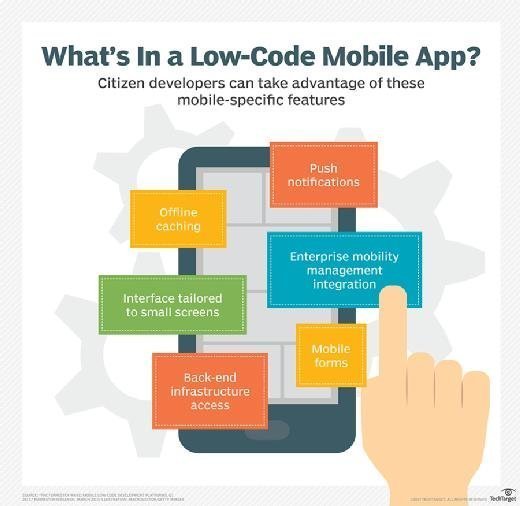Top Advice To Selecting Low-Code Platform Recommendations
The Advantages Of Low-Code Development For Application Development As It Pertains To Integration CapabilitiesLow-code application development offers significant advantages in the area of integration capabilities, which are essential for creating applications that can seamlessly integrate with various platforms and services. Here are a few major advantages: Pre-built connectors and APIs.
Connectors that are wide-ranging: Low code platforms include a large collection of connectors that are pre-built for common enterprise systems (e.g. ERP, CRM databases cloud services, etc.). This makes it easier to integrate with these systems.
API Integration - A lot of low-code platforms come with API integration, allowing developers easy access to other data sources or external services.
Ease Of Use
Drag-and-Drop Integration: Many integration tasks are performed with drag-and-drop interfaces. This lets developers and non-developers to build complicated integrations with minimal or no code.
Visual Workflow Builders : Tools for creating workflows and data flow which are visualized help learn and configure integrations in a much more simple way.
Standardized Integration Methods:
SOAP and Restful Service: Using standard web service protocols like SOAP and REST makes it simple to connect external systems and applications.
OData Other Standards: The support for standards such as OData facilitates the access and manipulation of data across platforms and applications.
Real-Time Data Synchronization:
Real-Time Integrations: Low-code platforms are capable of handling the real-time synchronization of data between systems, applications and databases. This ensures that data is up-to-date and consistent across an company.
Event-Driven architecture: Some platforms support event driven architectures. This lets applications react to events in real-time, which is essential for interactive and dynamic apps.
Legacy System Integration:
Low-code platforms: These platforms can be utilized to connect old systems to modern systems. They are a great option to upgrade your IT infrastructure without the need to completely overhaul your IT infrastructure.
Data Migration Tool: Built-in migration tools allow the data to be transferred from older systems to new software that are built on low code platforms.
Third-Party Integration of Services:
Integration with Cloud Services: Seamless integration with cloud-based services like AWS, Azure, and Google Cloud allows for the simple deployment and scaling of applications.
Business Applications Integration: Low-code platforms can be integrated with various business software like Salesforce, SAP and Microsoft Dynamics. This creates a seamless workflow between different business tasks.
Simple Data Management:
Data models that are unifying: Some platforms offer low-code support for unified data models to make data management easier across different systems.
Data Connectors: Pre-configured data connectors permit easy access to and manipulation of data from different sources.
Security and Compliance
Low-code platforms make sure that integrations are compliant with security protocols and standards to protect data during transit and while it is in its rest.
These platforms are usually equipped with features that help ensure compliance (e.g. HIPAA, GDPR) and provide assurance to companies handling sensitive information.
Extensibility:
Low-code platforms can often accommodate complex integration needs by including custom scripts or code. They offer flexibility without compromising their ease of use.
Plug-in Ecosystem : An ecosystem of extensions and plugins can extend integration capabilities through allowing users to create new features as needed.
In general, low-code development platforms offer powerful integration capabilities that make them a great tool for building interconnected and efficient applications. These platforms streamline the process of integrating disparate IT systems, boost the flow of information, and assist companies adopt technologies that are already in use, and also make use of new ones. Read the most popular Low-code Platform for application development for blog advice including rad application development, build a docker container, cross platform app dev, cross platform mobile dev, database in azure, software for app development, rapid app development, app platforms, mobile development platforms, develop mobile application and more.

Low-Code Application Development Offers Numerous Advantages In The Area Of Cost-Effectiveness.
The low-code method of application development is a cost-effective option that offers many advantages. It's a great option for companies who want to make the most of their budgets and deliver top-quality applications. The following are some key advantages.
Lower Coding Requirements: Low Coding platforms remove the need to code manually which saves developers time as well as money. This leads to lower costs of labor.
Less Developer Resources: Because low-code development is more efficient and easier, fewer developers are needed. This can significantly cut down on hiring and staffing expenses.
Faster Time to Market
Accelerated Cycle of Development: Visual tools for low-code platforms and components facilitate rapid development of applications, which allows companies to launch their products more quickly. This can lead to faster revenue growth and improved positioning in the market.
Rapid prototyping: By developing and testing prototypes in a short time companies can cut down on the time they spend in the development stage and enable faster iterations on the basis of user feedback.
Lower Maintenance Costs
Because of their modular architecture and standardised components, low-code platforms generally allow for easier maintenance of applications. This lowers the costs of maintaining the system over time.
Automated Patches and Updates: Low-code platforms can manage updating and patching applications automatically. This guarantees that your application remains secure and always up to date without requiring a lot of manual effort.
Efficient Resource Utilization:
Contributions by non-developers: Low-code platforms enable non-developers for example, business users to participate in the process of development. This democratization of development processes enables businesses to utilize the skills and talents of a wider number of employees.
Optimized IT Resource Use IT departments will be able concentrate on strategic initiatives, rather than being buried in mundane development tasks. This will increase the overall efficiency and productivity.
Scalable Pricing Models
Subscription Pricing: Many platforms that use low-code provide different pricing options based on subscriptions that can be scaled according to the amount of usage. This allows businesses to match their spending to the actual requirements and increase their revenue, without incurring large upfront costs.
Pay-As-You-Go options Certain platforms permit businesses to pay only for the amount they spend. This is particularly beneficial for small or new businesses that have limited budgets.
Reduce the cost of third-party software:
Low-code platforms are built-in with functions and integrations, which could reduce the cost of subscriptions to software and licensing.
Integrations pre-built: These systems and services integrate with other well-known services, reducing the requirement for custom-designed software, and can save time and cost.
Improved ROI:
More efficient return on investment (ROI) Through combining rapid application development with lower costs and a shorter time to market, businesses can achieve an increased ROI on their apps.
Improved Agility - Businesses can quickly adapt to changes in market and changing customer needs. This allows them stay current and take advantage of opportunities that come up.
Reduced Cost of Training
User-Friendly Interfaces: The simple, user-friendly interfaces of low-code platforms cut down on the learning curve for new users, and reduce the need for extensive training programs.
Accessible Resources - A lot of low-code platforms offer comprehensive training materials and tutorials and also community assistance. These tools reduce the need for formal instruction and its associated cost.
Collaboration can be made easier.
Improved Collaboration Tools : The collaboration tools that are built into the software aid in collaboration and communication between team members. This leads to an efficient development process and lower overhead.
Unified Development Environment : A unified environment simplifies work flows and lowers the cost of managing multiple tools and platforms.
The efficiency of low-code application development lies in its ability to lower maintenance and development costs, accelerate the time to market, maximize resources, and also offer flexible pricing models. Low-code can provide significant financial benefits for businesses. Take a look at the recommended Enterprise application development with Low-code Platform for site examples including sso azure, rad development, build a docker container, mobile app development platforms, push notifications android, application modernization software, multiplatform mobile app development, paas service, azure sql databases, application modernization software and more.

Advantages Of Low-Code Application Development In Terms Of Vendor Support And Community
Low-code platforms have significant advantages in terms of community and vendor support, both of which are vital to success in the implementation, maintenance and improvement of software. Here are a few of the major benefits: Support from vendors
Comprehensive Technical Support:
Support Teams: Several Low-Code platforms have a to a dedicated support team that assist with technical issues, help and troubleshooting.
24/7 Support: Some suppliers provide support 24/7, which is particularly beneficial for businesses that operate globally and in different time zones.
Training and Onboarding
Structured Training: A number of vendors offer structured training, like webinars, tutorials, and certification courses that aid users in becoming comfortable with the platform.
Personalized Onboarding: Many companies offer personalized onboarding to assist new customers use the platform efficiently and adapt it to their specific needs.
Regular Updates, Enhancements, and Improvements:
Continuous Improvements: Low-code providers frequently release updates, which include improvements in performance as well as new features and security patches to keep the platform up-to-date.
Feedback Integration: Vendors incorporate feedback from their users into their design cycles to ensure the platform is constantly evolving to meet the evolving needs of their users.
Comprehensive Documentation:
Documentation is thorough and users have the ability to access extensive and well-organized documents, ranging in terms of complexity from basic customization to advanced.
API References: API documentation is detailed and assists developers in integrating the platform with other systems, as well as modify their applications.
Professional and Consulting Services
Expert Consultation : Vendors provide consulting services, such as the design of architectures and complicated implementations. They offer this service to ensure that users are able take full advantage of the platform.
Custom Development Services: A few vendors offer custom development to build features or integrations for their customers which aren't readily available.
Community Support
Active User Community:
Discussion boards and forums Forums and discussion boards: A lot of low code platforms have active online communities that let users ask questions, exchange solutions and work together on best practices.
Local and virtual user groups, as well as Meetups, provide opportunities for users to exchange experiences, learn from others, and network.
Knowledge Sharing & Collaboration:
Community-Contributed Resources: Users often share templates, modules, and extensions that they have developed, which can be reused or adapted by others, accelerating development and innovation.
Crowdsourced Solutions: The collective experience the experience, expertise and experiences of a community may prove to be a useful tool in troubleshooting and finding creative solutions.
Learning and Development
Community-led training: Many community groups offer training sessions, webinars, and workshops led by professionals who are experienced in the area.
Online Tutorials and Courses: Members of the community create and share tutorials, online courses and step-by-step guides. This improves the educational resources accessible to the users.
Feedback and Influence
Product Feedback Channels: Community forums usually include channels for providing feedback to the vendor which may influence the development of new features and enhancements.
Beta Testing: Members of active communities might be eligible to take part. This lets them gain early access and be involved in the development of the platform.
Recognition and Support
Community Recognition Programs: Many vendors offer recognition programs to honor the efforts of active members of the community, such as MVP (Most Valuable Professional) programs.
Peer Support Peer Support: Community members frequently offer support to peers by sharing their knowledge and providing guidance for those who aren't as skilled. This helps create a more collaborative and supportive atmosphere.
The combination of strong vendor support and an engaged, active community creates a broad ecosystem of support for development with low-code. The combination of strong vendor support and an active, engaged community provides an entire support network for low-code development.
